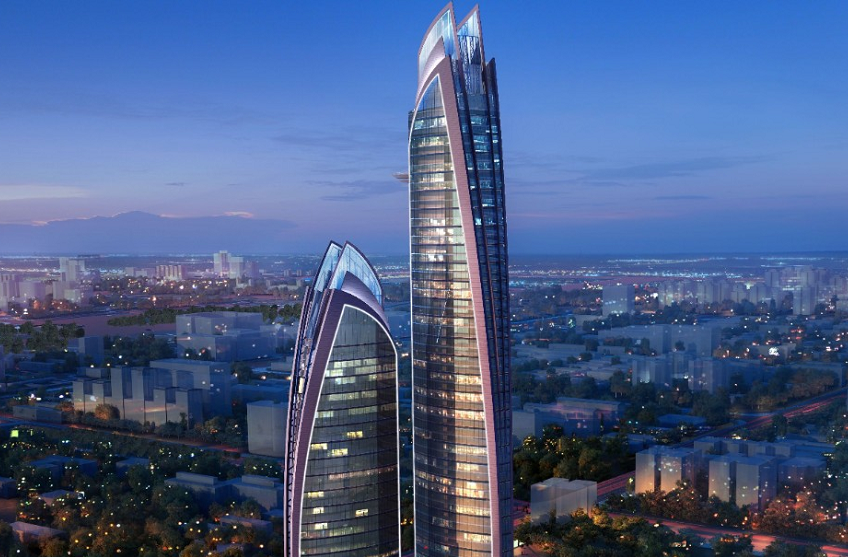Federico García Lorca said that “there is nothing poetic and terrible than the skyscrapers’ battle with the heavens that cover them”. In fact, this architectonical typology, in addition to its logical functionality -representing the maximum possible occupation of a surface- has an exceptional and immediately recognizable symbolism. There is no better way – or at least more effective – to publicize a new metropolis than building a remarkable skyscraper, and the cases of Honk Kong, Kuala Lumpur, and, more recently, Dubai or Astana, are a clear evidence of it.
After years of doubts about the development of skyscrapers as the paradigmatic typology of the contemporary metropolis, it has recently resurged with some projects that, moving between rationality and utopia, have put skyscrapers back to the main line of the architectonic world.
GO HIGH, GO EAST
Since the late 70s, the Mecca of skyscraper architecture has been transferred from the United States to the emergent Far East, being specially notable the example of Hong Kong, where the shortage of building land demanded to find new solutions able to solve the enormous demand of commercial buildings. Skyscrapers like the famous Bank of China designed by I.M. Pei (1990) or the Central Plaza (1992), helped to create Hong Kong’s spectacular skyline. The International Finance Centre (IFC), designed by Cesar Pelli, is currently, with its 407 meters in height, the tallest building in Hong Kong.
At the present time, the two tallest buildings in the world are in the Far East, but not in Hong Kong. The beautiful Taipei 101, designed by C. Y. Lee, with its 509 meters, have surpassed Kuala Lumpur ‘s Petronas Towers, that held, since 1998, the coveted title of “world’s tallest building” with their 452 meters in height. A Taiwan’s national pride, Taipei 101 includes impressive technological advances such as 60 elevators capable to surpass 60 km/h, or a tuned mass damper that protects the buildings against earthquakes.
When in 1998 the Petronas Towers in Kuala Lumpur were completed, the United States lost the top spot of the tallest buildings list, and it did not look like the situation was going to change. The 9/11 attacks that caused the collapse of the World Trade Center, added to the rumours of attempted terrorist attacks against other skyscrapers, like the Sears Tower or the John Hancock Centre, seemed to be the definitive coup de grace for the Americans.
However, in a strange example of patriotic pride, the tragic attacks accelerated the renaissance of American skyscraper that had been outlined years before with the projects financed by Donald Trump in New York and Chicago. Business Insider notes that the most evident example is the project that will replace the World Trade Centre in New York, the Freedom Tower, standing at a symbolic height of 1776 feet (540 meters) in commemoration of the American Independence.
But the most ambitious skyscraper projected for North America is the Chicago Spire, designed by Santiago Calatrava for the city of Chicago, which will begin to be built in early 2007, scheduled to be completed in 2010. Inspired in a smaller skyscraper byCalatrava (the “Turning Torso” in Mälmo, Sweden), the building, with its 610 meters in height, will continue the rich skyscraper tradition of the city of Chicago.
THE PETRODOLLARS COLOSSUSES
But it will not be America, not even the Far East, the home of the tallest buildings of the next decades. The world of the architecture-spectacle has, since September 2004, an eye permanently put in Dubai, where, financed with the all-powerful petrodollars, the colossal Burj Dubai is being built.
Projected by architect Adrian Smith from the Skidmore, Owings and Merrill office, the Burj Dubai will be a colossus of Islamic reminiscences whose final height is still a mystery. Initially suggested to be 808 meters, a recent article in Persian Gulf Extrusions states a final height of 940 metres. The construction of the skyscraper has caused some controversy, due to several press reports informing about the poor working conditions of the workers .
Pbs.org says that at the present time, another skyscraper of at least 700 meters in height, the Al Burj, is being projected in Dubai’s outskirts. Also, the future project of the Madinat al-Hareer in Kuwait includes a formidable tower said to be 1001 meters tall.
THE BIONIC UTOPIA
Apart from Frank Lloyd Wright’s impossible “One Mile Tower”, the most spectacular and utopian skyscraper ever conceived is the “Bionic Tower”, a spectacular project by Spanish architects Eloy Celaya, María Rosa Cervera and Javier Gómez Pioz for the Hong Kong bay, although “exportable” to any other coastal city willing to pay the $15 billion that would cost this building that would become the greatest wonder of the contemporary world.
More than a skyscraper, the bionic Tower is a “vertical city”, in which the residential units are distributed in 10 great levels. The circular footprint follow a vegetal model and include a massive central nucleus – destined to the vertical communications, with 368 elevators- surrounded by the residential and relax areas.
The project would be built in an artificial island measuring one kilometer in diameter, although the main tower would only occupy a surface area of 133 x 100 meters at its base. With its height of 1200 meters, and a capacity for 100.000 inhabitants, the Bionic Tower would suppose a colossal step in the ancestral human ambition to reach the sky.
